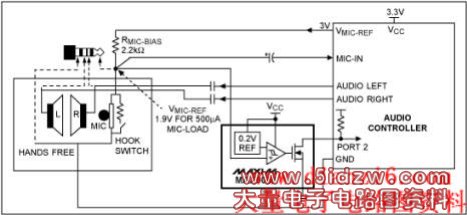To detect the type of headset connected, refer to Figure 4. Here a 2.2kΩ RMIC-BIAS resistor connects to a low-noise reference voltage from the audio controller (VMIC-REF). When an audio jack is inserted, this VMIC-REF voltage is applied through RMIC-BIAS to the tip-to-ground resistance (not shown), thus producing the voltage VDETECT at the noninverting input of the . This resistance can be small for stereo headphones (8Ω, 16Ω, or 32Ω), or high due to the microphone's constant-current sink which ranges from 100µA to about 800µA according to the type of microphone. Because VDETECT varies with the model of headset plugged in, the headset type is detected by monitoring VDETECT with a comparator.

Figure 4. A comparator circuit used for headset detection.
Assuming that the microcontroller's reference voltage (VMIC-REF) is 3V as shown, a 32Ω headphone load produces 43mV at VDETECT. A constant 500µA microphone load, however, produces 1.9V. Note that a direct interface for VDETECT can be challenging in most practical cases. Assuming that the CMOS inputs of a typical microcontroller port demand logic levels above 0.7 × VCC and below 0.3 × VCC, then the input logic for a controller operating with a 3.3V supply should be above 2.3V and below 1V.
A 1.9V level generated by a 500µA microphone load does not qualify as a valid logic 1. Microphone bias currents from 100µA to 800µA generate VDETECT levels from 2.78V to 1.24V, and any voltage below 2.3V violates the controller's VIH specification (input high level, assuming 2.2kΩ for RBIAS). To get 2.3V or above, the microphone bias current must be 318µA or less. Otherwise you must change the 2.2kΩ bias-resistor value which, in turn, changes the sensitivity point of the microphone. Generating a logic low of 1V and below is easy, because headphones with typical 32Ω loads can easily pull the level close to ground.
To detect the type of headset connected, you therefore feed VDETECT to one input of a comparator and a reference voltage to the other input. The comparator's output state then represents the type of headset.
The comparator for this portable headset-detect application should be tiny and consume little power. The comparator in Figure 4 is just 1mm × 1mm and draws a maximum supply current of only 1µA. Its strong immunity to cell-phone frequencies provides highly reliable operation. The comparator also has internal hysteresis and low-input bias currents. These features make it an excellent choice for headset detection in battery-operated, space- and power-sensitive applications like cell phones, portable media players, and notebook computers.
Hook-Switch Detection
Most hands-free headsets include a switch, usually known as a hook switch, that accepts and ends calls; provides the MUTE/HOLD function; and holds an ongoing call while receiving a second call. The microcontroller controlling the headset needs to detect the status of the hook switch and the presence of the headset. The jack (hence the headset) can be detected automatically (Figure 1). A signal for the hook-switch status can also be generated. Status-detection circuitry for the hook switch comprises a 4-connecter stereo headset with microphone and a parallel hook switch (Figure 5). (A mono headset is similar, but has a 3-pin connector.) In both headset types the tip is connected to the microphone in parallel with the hook switch. As shown, the hook switch presents a low resistance when pressed, and a high microphone resistance when open. As with the headset detection explained above, an interface between the headphone-detection voltage and the CMOS inputs of the microcontroller can complicate the circuit design for microphone/hook-switch detection.
Figure 5. Hook-switch detection circuitry using the MAX9063 comparator.
The voltage VDETECT (Figure 5) is pulled close to ground when the hook switch is pressed, and interpreted as logic 0 by the microcontroller. When the hook switch is open, however, VDETECT may violate the VIH spec for the CMOS inputs. Those VDETECT inputs can vary between 1.24V and 2.78V, depending on the value of RMIC-BIAS (2.2kΩ in this case) and the type of microphone in the headset.
Thus, a direct interface between the hook switch and the controller is not possible for all microphone types. Instead, a low-power comparator can be used as in Figure 5. Here the reference level is set to detect a given type of microphone, while also indicating the status of the hook switch. The comparator output is pulled high when the hook switch is pressed, and pulled low when the switch is open. Again, the MAX9060 series of comparators provides a low-power solution for these hook-switch-detect applications.
The scope shot of Figure 6 is triggered by pressing the hook switch of a mono headset. The setup is identical to that of Figure 5, but a 2.5mm universal headset for cell phones is used for the test. The headset tip has an electret microphone with hook switch and 32Ω speaker connected to its ring. That microphone draws a constant bias current of 212µA when powered with a 3V supply through the 2.2kΩ bias resistor.
Figure 6. These waveforms are taken from an electret microphone with hook switch, controlled by a mono headset and its internal control circuitry. When the hook switch of a mono headphone is pressed, the comparator detects the shorted microphone, thereby allowing its output to be pulled to a logic high.